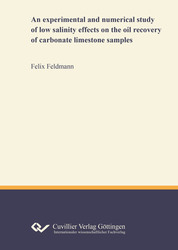| Fachbereiche | |
|---|---|
| Buchreihen (96) |
1378
|
| Nachhaltigkeit |
3
|
| Gesundheitswesen |
1
|
| Geisteswissenschaften |
2364
|
| Naturwissenschaften |
5406
|
| Mathematik | 229 |
| Informatik | 319 |
| Physik | 980 |
| Chemie | 1363 |
| Geowissenschaften | 131 |
| Humanmedizin | 243 |
| Zahn-, Mund- und Kieferheilkunde | 10 |
| Veterinärmedizin | 108 |
| Pharmazie | 147 |
| Biologie | 835 |
| Biochemie, Molekularbiologie, Gentechnologie | 121 |
| Biophysik | 25 |
| Ernährungs- und Haushaltswissenschaften | 45 |
| Land- und Agrarwissenschaften | 1004 |
| Forstwissenschaften | 201 |
| Gartenbauwissenschaft | 20 |
| Umweltforschung, Ökologie und Landespflege | 148 |
| Ingenieurwissenschaften |
1793
|
| Allgemein |
98
|
|
Leitlinien Unfallchirurgie
5. Auflage bestellen |
|
Erweiterte Suche
An experimental and numerical study of low salinity effects on the oil recovery of carbonate limestone samples
Felix Feldmann (Autor)Vorschau
Inhaltsverzeichnis, PDF (530 KB)
Leseprobe, PDF (590 KB)
Low-salinity waterflooding is a relatively simple and cheap Enhanced oil recovery technique in which the salinity of the injected water is optimized (by desalination and/or modification) to improve oil recovery over conventional waterflooding. The presented study combines spontaneous imbibition, centrifuge method, unsteady state coreflooding and zeta potential experiments to investigate low-salinity effects in carbonate limestones samples.
Compared to Formation-water and Sea-water, Diluted-sea-water caused the significantly highest spontaneous oil recovery. Moreover, the imbibition capillary pressure curves are characterized by an increasing water-wetting tendency and a residual oil saturation reduction, as the salinity of the imbibing brines decreases in comparison to Formation-water. The unsteady state corefloodings resulted in the highest secondary oil recovery when Diluted-sea-water was used as injection water.
Based on the open-source C++ simulator Dumux, the study developed a numerical centrifuge and coreflooding model to history match the experimental data. The numerically derived capillary pressure and relative permeability data confirm a correlation between the system’s salinity, wettability, oil recovery and residual oil saturation.
| ISBN-13 (Printausgabe) | 9783736971769 |
| ISBN-13 (E-Book) | 9783736961760 |
| Buchendformat | A5 |
| Sprache | Englisch |
| Seitenanzahl | 254 |
| Auflage | 1. |
| Erscheinungsort | Göttingen |
| Promotionsort | Clausthal |
| Erscheinungsdatum | 02.03.2020 |
| Allgemeine Einordnung | Dissertation |
| Fachbereiche |
Geowissenschaften
Petrologie, Lagerstättenkunde |
| Schlagwörter | Boundary conditions, Boundary formulation, Capillary pressure, Carbonates, Centrifuge method, Contact angle, Core aging, Core preparation, Coreflooding, Crude oil, Cydar, Diluted sea water, Dumux, Enhanced oil recovery, Forbes first solution, Forced imbibition, Formation water, Hassler Brunner, History matching, Improved oil recovery, Inlet water saturation correction, Interfacial tension, Limestone, Low salinity, Low salinity literature review, Low salinity mechanism, Numerical Modelling, Numerical Simulation, Open source simulator, Outcrops, Relative permeability, Remaining oil saturation, Residual oil saturation, Salinity impact, Sea water, Special core analysis, Special core analysis simulation, Spontaneous imbibition, Surface charge change, Zeta potential, Petroleum Engineering, Reservoir Engineering |








